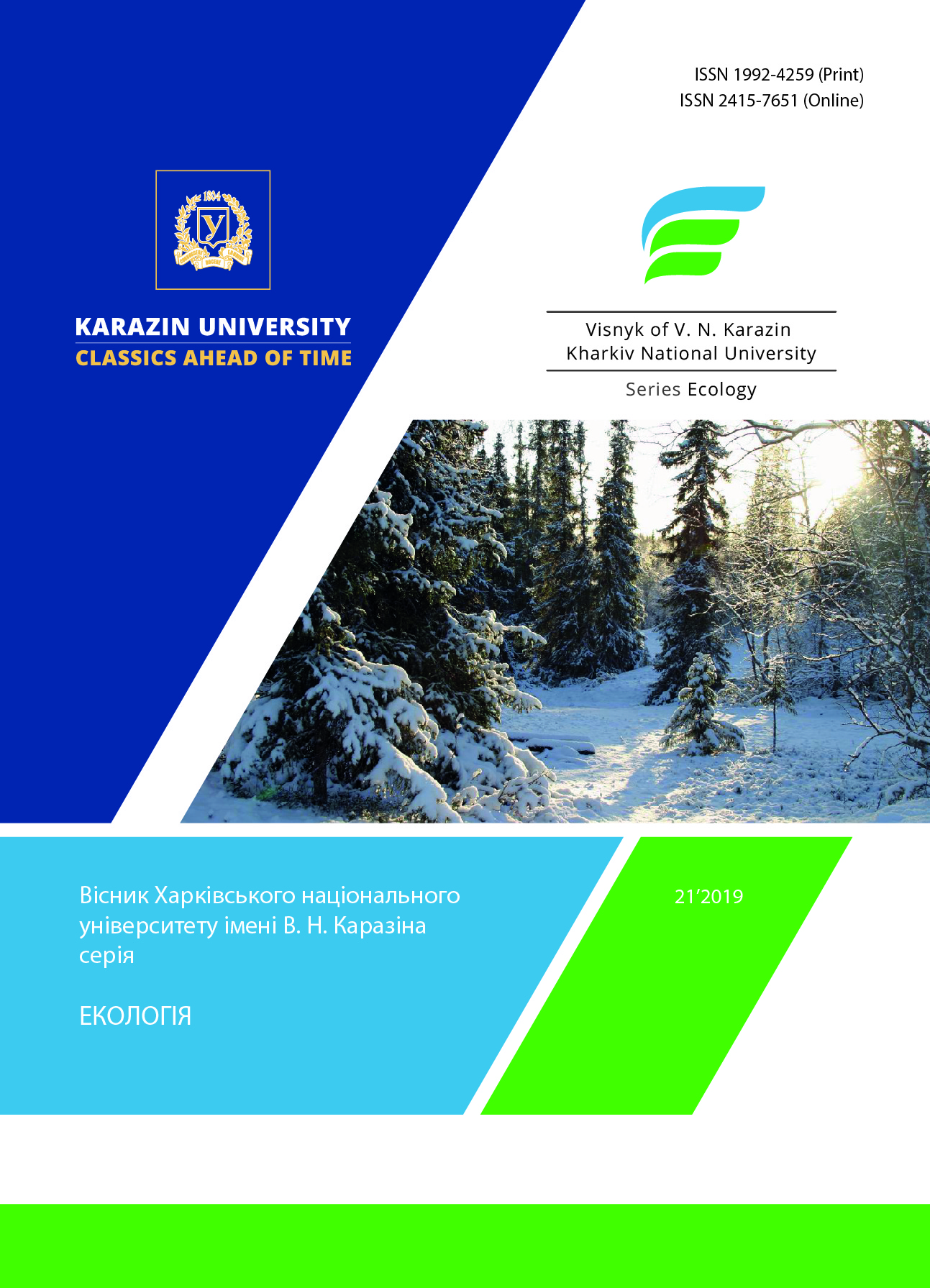Трансформація водозбірного басейну р. Уди в межах м. Харків
Ключові слова:
ландшафтне планування, антропогенна трансформація, ландшафт, урбанізація, водозбірний басейн, структура землекористування, р. Уди, ХарківАнотація
Мета дослідження - оцінка ступеню антропогенної трансформації ландшафту водозбірного басейну внаслідок містобудівного освоєнная та виявлення шляхів нормування навантаження на ландшафти у ході розвитку міста. Методи. У ході дослідження використаний комплекс методів: експертна оцінка, картографічні методи (зокрема операції картометрії) та геоінформаційне моделювання рельєфу. Результати. У ході дослідження виявлено, що урбогенна трансформація природних ландшафтів передусім відбувається внаслідок формування системи землекористувань, що спонукає заміну екологічних функцій ландшафту суспільними. Здійснена на основі геоінформаційного моделювання рельєфу ландшафтна диференціація водозбірного басейну, дозволила виявити просторову конфігурацію та площі кожної з його підсистем. Встановлено, що заплавна підсистема займає 8,47 %, надзаплавно-терасова – 21,4 %, схилова підсистема – 17,49 %, а вододільно-рівнинна – 52,64 % від площі території досліджуваного водозбірного басейну. Висновки. В результаті обчислення коефіцієнтів трансформації типів землекористування та їх сумації в межах кожної з підсистем встановлено, що найбільший ступінь трансформації ландшафтів має вододільно-рівнинна підсистема. Середнім ступенем трансформації характеризується надзаплавно-терасова та схилова підсистеми. Найнижчий показник коефіцієнту антропогенної трансформації в межах водозбірного басейну має заплавна підсистема. Для території заплавної підсистеми здійснено зонування території за рівнем антропогенного навантаження на ландшафт водозбірного басейну. Для кожної з зон запропоновано екологічні заходи.
Посилання
Андреев Д. Н. Методика комплексной диагностики антропогенной трансформации особо охраняе-мых природных территорий. Географичекий вестник. Физическая география и геоморфология. 2012. №4. С. 4–10.
Гродзинський М. Д. Ландшафтна екологія: підручник. Київ : Знання, 2014. 550 с.
ДНВП "Геоінформ України". Державна геологічна карта України. 1998. URL : http://geoinf.kiev.ua/wp/kartograma.htm.
Іванов Є. А., Ковальчук І. П. Антропогенізація ландшафтів : підходи, діагностування, моделювання. Науковий вісник Чернівецького університету. 2012. №612. С. 54–59.
Каганский В. Л. Культурный ландшафт : Основные концепции в российской географии. Обсерва-тория культуры: журнал-обозрение. 2009. №1. С. 62–70.
Каленська О., Сакаль О. Агроландшафти: поняття, суб’єкти і фактори трансформації. Економіка природокористування. 2015. №3. С. 26–29.
Карпенко Н. П. Оценка геоэкологической ситуации речных бассейнов на основе атрибутивных по-казателей и обощенных геоэкологических рисков. Природообустройство. 2018. №2. С. 15–22.
Клєщ А. А., Самойлова Ю. В. Організація водоохоронних зон в містах України : методичні проблеми та шляхи їх вирішення засобами ландшафтно-екологічного планування. Людина та довкілля. Проблеми неоекології. 2019. № 31. С. 26–39.
Клєщ А. А., Максименко Н. В., Пономаренко П. Р. Територіальна структура природокористування міста Харків. Людина та довкілля. Проблеми неоекології. 2017. №1–2. С. 23–34.
Койнова І. Б. Антропогенна трансформація ландшафтних систем західної частини Волинського По-лісся : автореф. дис. на здобуття наук. ступеня канд. геогр. наук : 11.00.11. Львів, 1999. 23 с.
Колбовский Е. Ю. Ландшафтное планирование : учеб. пособие. Москва : Академия, 2008. 336 с.
Максименко Н. В., Гоголь О. М. Комплексний ландшафтно-екологічний індекс як підґрунтя для оцінки стану територій. Проблеми безперервної географічної освіти і картографії.2016. Вип. 24. С. 61–67.
Міхелі С. В. Дослідження антропогенних змін ландшафтів в Україні : концептуальні засади, центри розвитку, результати. Наукові записки Вінницького педуніверситету. Географія. 2013. №25. С. 12–19.
Петлін В. М. Проблеми теорії та методології антропогенного ландшафтознавства. Наукові записки Вінницького педуніверситету. Географія. 2013. №25. С. 20–25.
Самойленко В. М., Пласкальний В. В. Концепції ідентифікації міри антропізації ландшафтів: ретро-спектива та перспективи. Фізична географія та геоморфологія. 2015. №4. С. 19–38.
Самойленко В. М., Пласкальний В. В. Ситематизація концепції ідентифікації міри антропогенізації ландшафтів. Загальні методичні аспекти досліджень. Гідрологія, гідрохімія і гідроекологія. 2016. №1. С. 6–29.
Теліш П. Антропогенна трансформація території регіонального ландшафтного парку «Верхньодніс-тровські Бескиди» та шляхи їх зменшення. Вісник Львівського університету. Серія географічна. 2014. N 48. С. 313–321.
Хальбаева С. Р. Антропогенная трансформация природных систем Гусиноозерской котловины. Ве-стник Бурятского государственного университета. 2012. №4. С. 72–74.
Чир Н. В. Розрахунок ступеня антропогенного навантаження на ландшафти басейнів малих річок (на прикладі річки Вижівка). Збірник наукових праць Військового інституту Київського національ-ного університету імені Тараса Шевченка. 2014. №45. С. 301–306.
Шищенко П. Г. Принципы и методы ландшафтного анализа в региональном проектировании. Киев : Фитосоцио-центр, 1999. 284 с.
##submission.downloads##
Опубліковано
Номер
Розділ
Ліцензія
Автори, які публікуються у цьому журналі, погоджуються з наступними умовами:
- Автори залишають за собою право на авторство своєї роботи та передають журналу право першої публікації цієї роботи на умовах ліцензії Creative Commons Attribution License 4.0 International (CC BY 4.0), котра дозволяє іншим особам вільно розповсюджувати опубліковану роботу з обов'язковим посиланням на авторів оригінальної роботи та першу публікацію роботи у цьому журналі.
- Автори мають право укладати самостійні додаткові угоди щодо неексклюзивного розповсюдження роботи у тому вигляді, в якому вона була опублікована цим журналом (наприклад, розміщувати роботу в електронному сховищі установи або публікувати у складі монографії), за умови збереження посилання на першу публікацію роботи у цьому журналі.
- Політика журналу дозволяє і заохочує розміщення авторами в мережі Інтернет (наприклад, у сховищах установ або на особистих веб-сайтах) рукопису роботи, як до подання цього рукопису до редакції, так і під час його редакційного опрацювання, оскільки це сприяє виникненню продуктивної наукової дискусії та позитивно позначається на оперативності та динаміці цитування опублікованої роботи (див. The Effect of Open Access).

